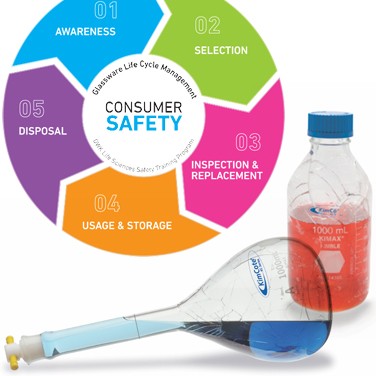The Cost of Risk May Be Defined Only After an Accident Occurs
We all share the common experience of breaking a wine glass or a coffee cup. But in the lab, damage from broken glass can have much greater consequences than spilling your favorite merlot on your new shoes.
For example, if a flask breaks, there is risk of getting cut. And if the flask contains dangerous contents, that risk extends to nearby personnel through splash, vapors, fire risk, equipment damage, and more.
You can better address these risks by understanding the various types of glass and their use, care, and safe disposal practices. It is recommended that you implement a proper glass safety standard operating procedure (SOP) to strengthen lab safety, mitigate risk, and help avoid financial loss. Unfortunately, consideration of financial loss sometimes occurs only after an accident occurs. So how do you get started?
Regulatory Standards
A major difference between consumer and laboratory glassware involves standards, regulations, and practices for manufacture and use. Lab glassware has purity and calibration requirements, should be handled to reduce thermal stress, and requires proper cleaning. In regulated labs, your records of the physical inspection of glassware for proper function and conformance will be reviewed by inspectors.
ASTM International (formerly the American Society of Testing & Materials) is a global organization that helps establish standards for the manufacture of laboratory glassware, including materials, testing, calibration, and other manufacturing procedures. For example, ASTM Method E671 sets limits on acceptable thermal stress levels for annealed glass and offers guidelines for testing, calibration, and maintenance.
Regulatory authorities that follow ASTM standards include the U.S. Environmental Protection Agency (EPA), the U.S. Department of Agriculture (USDA), the U.S. Food and Drug Administration (FDA), the AOAC (formerly the Association of Official Agricultural Chemists), and the U.S. National Institute of Standards and Technology (NIST), among others.
Make sure the manufacturer of your lab glassware complies with these standards for safety, purity, and performance.
Selection of Glass Types in the Lab
In the laboratory, soda lime and borosilicate glass predominate. Soda lime glass is used mostly for jars and containers, and it cannot be autoclaved (sterilized). Borosilicate glass is formulated to withstand thermal shock, can be autoclaved, and resists breakage.
Awareness and understanding of glass differences is critical. Analytical and chromatography glassware should be either Type 33 or 51 borosilicate glass. Never autoclave glass unless the manufacturer indicates it is safe to do so.
Application Considerations
Factors such as chemical attack, sample-glass interactions, thickness, content photosensitivity, washing solvents, and calibration are also important when choosing the right glass type for a procedure.
Life Cycle Management
Life cycle management includes the regular inspection and proper maintenance of reusable glassware. The human eye cannot detect some indications of stress — by the time scratches, scrapes, and damage are visible, it’s too late.
Alan Arnold Griffith, an English engineer, studied glass stress and fracture. In the 1920s, he discovered what are known as Griffith Flaws, which are introduced by the mechanical stress of day-to-day laboratory use and improper uses like scratching, flexing, bending, and dropping.
Use a polariscope periodically to inspect your glassware for signs of damage. Inspect and dispose of stressed glass to help prevent injuries and collateral damage.
You may also opt to simply replace your glassware on a scheduled basis. If you use serialized or color-coded glassware, you can track usage, or change colors after a span of two or three years. For maximum risk prevention, use safety-coated bottles that help contain the contents if the glass breaks.
Ask these questions before an accident occurs:
- What risks are associated with routine daily use or improper cleaning or handling?
- Are we reducing or increasing the creation of Griffith Flaws during use?
- Do our glass usage SOPs address replacement, disposal, or calibrations?
A well-designed and implemented SOP limits your financial loss, improves lab operations, and mitigates safety and regulatory risks.
Now that you understand more about the risks, take action! Try the free DWK Life Sciences on-site or webinar-based Glassware Safety Training. Contact your Fisher Scientific sales representative to schedule a training session.
Visit fishersci.com/glasssafety to learn more.



